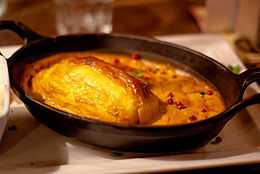Quenelle

A quenelle (French pronunciation: [kə.nɛl]) is a mixture of creamed fish, or meat, sometimes combined with breadcrumbs, with a light egg binding.[1] It is usually poached. Formerly, quenelles were often used as a garnish in haute cuisine. Today, they are usually served on their own.
Lyon and Nantua are famous for their quenelles de brochet (mousseline) (pike quenelles), often served with cream sauce and run under a broiler. Pike has many small bones, so passing it through a tamis is an expeditious way of removing them.
The word quenelle is derived from the German Knödel (noodle or dumpling).[2]
Quenelle may also refer to a food item made into an oval or egg shape, such as ice cream, sorbet, or mashed potato quenelles. This usage derives from the original shape of the egg-and-meat quenelle.
It can also be served vegetarian, or "nature".
Similar items are found in many cultures. The Romans are believed to have introduced this type of food to Western Europe.
Preparation
There are many ways to prepare quenelles de brochet, but most recipes first prepare a panade, essentially a white sauce, then combine the panade with fish, and put the mixture through a sieve such as a tamis, yielding a forcemeat. The quenelles are shaped from the forcemeat and then poached. They may be served sauced and grilled, or with a variety of sauces.[3]
See also
- Lyonnaise cuisine
- Colette Sibilia
- Gefilte fish
References
- ↑ Larousse Gastronomique, 1961
- ↑ Dictionaire Général pour la maîtrise de la langue française la culture classique et contemporaine. Larousse. 1993. p. 1297. ISBN 2-03-320300-X.; Petit Robert, 1972; Oxford English Dictionary, Draft Revision, Dec. 2007; the old Larousse Gastronomique, however, reports that some writers trace it to an Old English word knyll.
- ↑ Ann Pringle Harries, "Fare of the Country: Delicate Pike Quenelles, a Lyons Tradition", New York Times, August 4, 1991